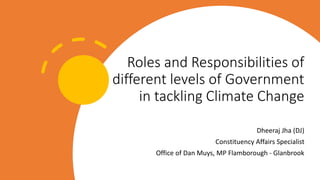Climate Change.pptx
- 1. Roles and Responsibilities of different levels of Government in tackling Climate Change Dheeraj Jha (DJ) Constituency Affairs Specialist Office of Dan Muys, MP Flamborough - Glanbrook
- 2. The Reality Climate Change is a reality Average increase of temperature in Canada in last 70 years is about 1.7C Change is apparent in form of variation, duration, frequency and timings Our infrastructures are not adequate
- 4. Powers to regulate Environment The constitution Act 1867 does not include a distinct legislative power regarding the environment. As a result, both Parliament and the provincial legislatures can legislate in the area. To determine which level of government may deal with an environmental matter, it is necessary to identify the power enumerated in the Constitution Act, 1867 that best matches the essence of the legislative or regulatory measure in question. Tackling Climate change requires co-ordination at every levels.
- 5. Power to regulate related with Air Emissions Federal âĒ Regulate emissions from aviation, interprovincial transportation âĒ Regulate release of toxic substances âĒ GHGs Provincial âĒ Jurisdiction to regulate over emissions from most types of industries âĒ GHGs
- 6. Greenhouse Gas Emissions âĒ The provinces and territories have broad jurisdiction to regulate greenhouse gas emissions. They may directly regulate emissions from industries and activities under their jurisdiction. - Provincial taxation power, they may impose a provincial carbon tax. - Power to regulate property and civil rights, the provinces may impose levies and establish emissions trading schemes, such as cap-and-trade schemes âĒ The federal governmentâs ability to regulate greenhouse gas emissions is based in its authority, under the Constitution, to regulate several different subject matters. - Federal power to impose taxes - May regulate emissions emanating from industries under federal jurisdiction, such as shipping and aviation. - under the criminal law power, the federal government to regulate emissions of these gases regardless of the source. - Power to regulate trade and commerce
- 7. Responsibilities of Municipalities Building permits Community improvement plans Cycling and pedestrian infrastructure Land use planning Public Transit Transportation Planning
- 8. Importance of Municipalities Disaster struck at local levels. Considerable expertise in dealing with challenges Lack of Funds, Functions and Functionaries Infrastructure is not adequate
- 9. Do It Yourself Carbon Tax â Federal Vs Alberta Stop Urban Boundary â Ontario Vs Hamilton City Council Green Belt â Ontario Vs other municipalities Highway 413
- 10. Randal Reef âĒ 150 years of accumulated coal tar and other industrial pollution â located in the harbour near pier 15 âĒ 615,000 cubic meters of toxic sludge âĒ Project cost was $139 million â City of Hamiltonâs share - $14 million
- 11. Greensville against Garbage Carmeuse Lime Canada planning to burn Alternative Low Carbon Fuels to produce lime/clinker Located near Brock Road and Hwy #5 Approached us --- What to do?
- 12. Itâs all about the people.











